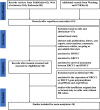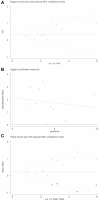Survival association of XRCC1 for patients with head and neck squamous cell carcinoma: A systematic review and meta-analysis
- PMID: 36685969
- PMCID: PMC9849232
- DOI: 10.3389/fgene.2022.1035910
Survival association of XRCC1 for patients with head and neck squamous cell carcinoma: A systematic review and meta-analysis
Abstract
Background: Epidemiologic studies have demonstrated that X-ray repair cross-complementary group 1 (XRCC1) is one of the susceptibility factors in head and neck squamous cell carcinoma (HNSCC) patients. However, its clinical prognostic impact remains controversial. Thus, a meta-analysis was performed to clarify the association between XRCC1 and the survival outcomes in HNSCC patients. Methods: Following the Preferred Reporting Items or Systematic Reviews Meta Analyses (PRISMA) 2020 guidelines, literature searches were systematically performed in PubMed, EMBASE, Web of Science, Wanfang, and Chinese National Knowledge Infrastructure (CNKI) databases with manual retrieval. Hazard ratios (HRs) and 95% confidence intervals (CIs) were collected to estimate the correlation between XRCC1 and the survival outcomes of HNSCC patients. Results: Ten studies including 1995 HNSCC patients who satisfied the inclusion and exclusion criteria were included in this meta-analysis. Pooled analysis indicated that XRCC1 Arg399Gln and XRCC1 high protein expression were significantly correlated with poor overall survival with HR of 1.31 (95% CIs: 1.03-1.66, p = 0.027) and 2.32 (95% CIs: 1.55-3.48 p = 0.000) in HNSCC patients. In addition, our results demonstrated that XRCC1 was significantly associated with poor progression-free survival (HR = 1.42, 95% CIs: 1.15-1.75, p = 0.001) in HNSCC patients. ConclusionThis meta-analysis demonstrated that XRCC1 Arg399Gln and XRCC1 high protein expression increase the risk of poor survival for HNSCC patients. XRCC1 is a potential therapeutic target for HNSCC.
Keywords: X-ray repair cross-complementing 1; head and neck squamous cell carcinomas; meta-analysis; polymorphism; survival.
Copyright © 2023 Yang, Zhou, Chen, Luo and Wang.
Conflict of interest statement
The authors declare that the research was conducted in the absence of any commercial or financial relationships that could be construed as a potential conflict of interest.
Figures





Similar articles
-
Association of X-ray repair cross complementing group 1 Arg399Gln polymorphisms with the risk of squamous cell carcinoma of the head and neck: evidence from an updated meta-analysis.PLoS One. 2013 Oct 30;8(10):e77898. doi: 10.1371/journal.pone.0077898. eCollection 2013. PLoS One. 2013. PMID: 24205020 Free PMC article.
-
Association between XRCC1 Arg399Gln polymorphism with prognosis of head and neck squamous cell carcinomas: A meta-analysis.Heliyon. 2023 Oct 18;9(10):e21111. doi: 10.1016/j.heliyon.2023.e21111. eCollection 2023 Oct. Heliyon. 2023. PMID: 37916104 Free PMC article.
-
The Association Between the XRCC1 Arg399Gln Polymorphism and the Risk of Head and Neck Cancer: An Updated Meta-Analysis Including 14586 Subjects.Technol Cancer Res Treat. 2021 Jan-Dec;20:15330338211033060. doi: 10.1177/15330338211033060. Technol Cancer Res Treat. 2021. PMID: 34278875 Free PMC article.
-
XRCC1 Arg399Gln and clinical outcome of platinum-based treatment for advanced non-small cell lung cancer: a meta-analysis in 17 studies.J Zhejiang Univ Sci B. 2012 Nov;13(11):875-83. doi: 10.1631/jzus.B1200083. J Zhejiang Univ Sci B. 2012. PMID: 23125080 Free PMC article. Review.
-
The prognostic significance of survivin expression in patients with HNSCC: a systematic review and meta-analysis.BMC Cancer. 2021 Apr 17;21(1):424. doi: 10.1186/s12885-021-08170-3. BMC Cancer. 2021. PMID: 33863308 Free PMC article.
References
Publication types
LinkOut - more resources
Full Text Sources

